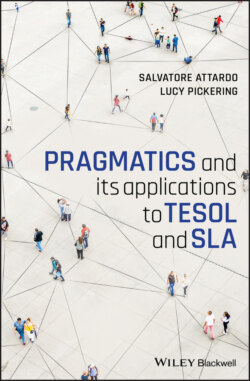Читать книгу Pragmatics and its Applications to TESOL and SLA - Salvatore Attardo - Страница 6
Figures
Оглавление1.1 Image of a cat.
1.2 A sign is the union of a signifier and a signified.
1.3 The indirect relationship between the sounds and the referent, mediated by the sign.
1.4 The Morse code.
1.5 Partition for the beginning of a Rachmaninoff piece with largo tempo.
1.6 The semantic Network of “chair.” “isa” labels hyponymy links.
1.7 The Müller-Lyer figures.
5.1 FTA strategies; adapted from Brown and Levinson (1987, p. 69).
5.2 Degrees of (im)politeness and types of polite/politic behavior.
5.3 Thanking gesture in Indian culture.
5.4 Thanking gestures in other cultures.
6.1 Jakobson’s Model.
6.2 A paratone, displaying the typical declination (solid line) and resets (dashed lines).
6.3 The “schools” of functionalism.
7.1 The deictic Space.
7.2 Thestance triangle (adapted from Du Bois, 2007).
7.3 Instances of well in COCA.
8.1 The evolution of the communicative competence model (Adapted from Celce-Murcia et al., 1995).
9.1 Recording of an ITA teaching in a chemistry laboratory, using a headset.
9.2 A screenshot from CARLA.
10.1 No parking sign in China.
10.2 Directional arrow Signs.
10.3 The Eiffel tower. Photograph.
10.4 The Eiffel tower. Drawing.
11.1 The hierarchy of world languages; adapted from de Swaan (2001) and Cook (2013, p. 190).
11.2 Broca’s and Wernicke’s areas.
11.3 Brain activity patterns in bilinguals (from Perani & Abutalebi, 2005, p. 203.).
